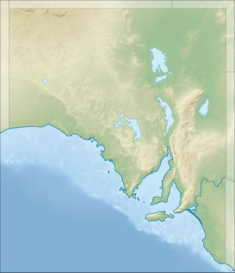
The Australian Army is Australia's military land force. Formed in 1901 through the amalgamation of the Australian colonial forces following federation, it is part of the Australian Defence Force (ADF) along with the Royal Australian Navy and the Royal Australian Air Force. While the Chief of the Defence Force (CDF) commands the ADF, the Army is commanded by the Chief of Army (CA). The CA is therefore subordinate to the CDF, but is also directly responsible to the Minister for Defence. Although Australian soldiers have been involved in a number of minor and major conflicts throughout Australia's history, only during the Second World War has Australian territory come under direct attack.
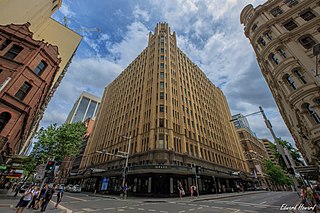
The Grace Building is a heritage-listed building of the Federation Skyscraper Gothic style that houses a bar, hotel, cafe and restaurant and is located at 77-79 York Street in the Sydney central business district in New South Wales, Australia.

The Sydney Mint in Sydney, New South Wales, Australia, is the oldest public building in the Sydney central business district. Built between 1811 and 1816 as the southern wing of the Sydney Hospital, it was then known as the Rum Hospital. In 1854 a mint was established on the site with the hospital building used to house mint staff as well as providing a residence for the Deputy Mint Master. A coining factory was built at the rear. Both of these structures have exceptional heritage significance and have been associated with major events in the colonial history of New South Wales.

This article describes the current structure of the Australian Army. It includes the army's order of battle and the headquarters locations of major units. Members of the Australian Army also serve within joint units of the Australian Defence Force which fall outside the direct command of the Australian Army.

Victoria Barracks is an Australian Army base in Sydney, New South Wales, Australia. Victoria Barracks is located in the suburb of Paddington, between Oxford Street and Moore Park Road. It is just north of the Moore Park, the Sydney Cricket Ground and Sydney Football Stadium. Victoria Barracks houses the Headquarters Forces Command.

The Army Museum of Western Australia is a museum located in an historic artillery barracks on Burt Street in Fremantle, Western Australia. The museum was established in 1977 and has three Victoria Crosses on display.

The Albury railway station is a heritage-listed railway station at Railway Place, Albury, New South Wales, Australia, adjacent to the border with Victoria, in Australia. It was designed by John Whitton and built from 1880 to 1881. It was added to the New South Wales State Heritage Register on 2 April 1999.
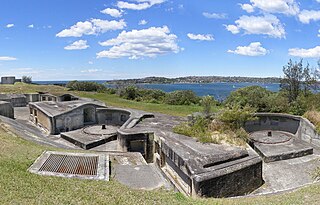
The Middle Head Fortifications is a heritage-listed former defence establishment and military fortifications and now public space located at Middle Head Road, Middle Head, Mosman in the Mosman Council local government area of New South Wales, Australia. It is also known as the Middle Head Military Fortifications or The Old Fort. The fortifications consist of the Outer Middle Head Battery located at the end of Old Fort Road, the Inner Middle Head Battery located at the end of Governors Road, and the Obelisk batteries reached by a path from the corner of Middle Head Road and Chowder Bay Road. The fortifications at Middle Head formed part of Sydney Harbour's defences. The property is owned by the NSW Office of Environment and Heritage. It was added to the New South Wales State Heritage Register on 2 April 1999.
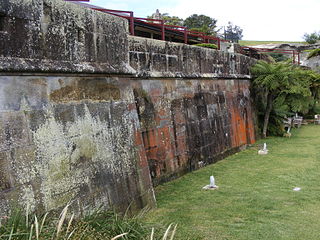
The Georges Head Battery, also called the Georges Head Military Fortifications, is a heritage-listed former military fortification located on the Georges Head on Chowder Bay Road, Georges Heights, in the suburb of Mosman, in the Mosman Council local government area of New South Wales, Australia.
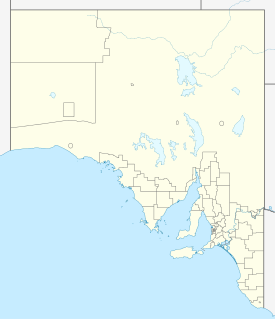
Keswick Barracks is a barracks of the Australian Army in Keswick, South Australia. The barracks are located on Anzac Highway adjacent to the Royal Adelaide Showgrounds. The base is separated from the Showgrounds by the Seaford and Belair railway lines.
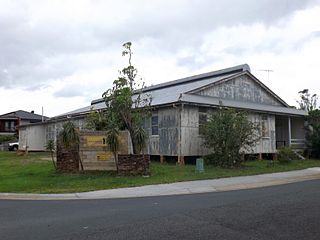
Annerley Army Reserve Depot is a heritage-listed barracks at 158 Dudley Street, Annerley, City of Brisbane, Queensland, Australia. It was built from 1914 to 1954. It was added to the Queensland Heritage Register on 7 February 2005.
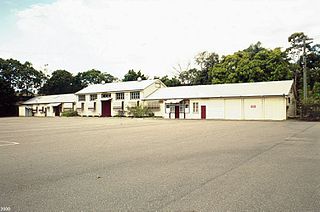
Gona Barracks is a heritage-listed barracks at 3, 7,12, 25 & 26 Gona Parade, Kelvin Grove, City of Brisbane, Queensland, Australia. It was built from c. 1914 to 1960s. It is also known as Kelvin Grove Military Reserve and Kelvin Grove Training Area. It was added to the Queensland Heritage Register on 7 February 2005.

Kissing Point Fortification is a heritage-listed fortification at 38-40 Howitt Street, North Ward, City of Townsville, Queensland, Australia. It was designed by Peter Scratchley and Major Edward Druitt and built from 1891 by A McMillan and then from 1939 to 1941. It is also known as Jezzine Barracks. It was added to the Queensland Heritage Register on 5 February 2010.
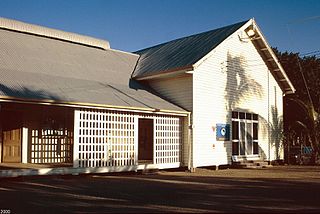
North Ward Defence Complex is a heritage-listed barracks at 46 Oxley Street, North Ward, City of Townsville, Queensland, Australia. It was built from 1885 to c. 1942. It is also known as 11 Brigade Administration Support Battalion Headquarters Company and Oxley Street Defence site. It was added to the Queensland Heritage Register on 25 August 2006.
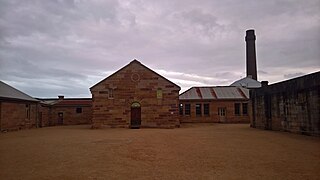
Prison Barracks Precinct is a heritage-listed prison precinct at Cockatoo Island, Sydney Harbour, New South Wales, Australia. It was added to the Australian Commonwealth Heritage List on 22 June 2004.

Queenstown Post Office is a heritage-listed post office at 32-34 Orr Street, Queenstown, Tasmania, Australia. It was designed by the Tasmanian government's Public Works Office and built in 1902, with the tower added in 1909. It was added to the Australian Commonwealth Heritage List on 22 June 2004.

The Small Arms Magazine is a heritage-listed former military installation at Murray Avenue, Gallipolli Barracks, Enoggera, Brisbane, Queensland, Australia. It was added to the Australian Commonwealth Heritage List on 22 June 2004.

School of Musketry is a heritage-listed former military installation at 431 Lloyd Street, Gallipoli Barracks, Enoggera, Brisbane, Queensland, Australia. It was added to the Australian Commonwealth Heritage List on 22 June 2004.

Enoggera Magazine Complex is a heritage-listed military installation at Inwood Road, Gallipoli Barracks, Enoggera, Brisbane, Queensland, Australia. It was added to the Australian Commonwealth Heritage List on 22 June 2004.

Remount Complex is a heritage-listed former military installation at Wynter Road, Gallipoli Barracks, Enoggera, Queensland, Australia. The former Remount Complex is an important group of early twentieth century Australian Government defence buildings at the former Enoggera Army Camp, now known as Gallipoli Barracks. A group of five buildings, the Remount Section is a significant link to a famous, almost legendary, tradition of the Australian military: mounted units such as the Light Horse.It was added to the Australian Commonwealth Heritage List on 22 June 2004.
